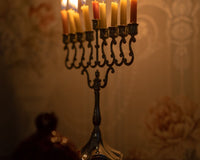What is the Crown Of Thorns
The Crown of Thorns is a symbolic relic associated with the Passion of Jesus Christ, particularly his crucifixion. According to the Christian Bible, during the events leading up to Jesus' crucifixion, Roman soldiers placed a crown made of thorns on his head as a form of mockery and humiliation. This act is described in the New Testament, for example, in the Gospel of Matthew (27:29), where it says, "And when they had platted a crown of thorns, they put it upon his head, and a reed in his right hand: and they bowed the knee before him, and mocked him, saying, Hail, King of the Jews!"
The Crown of Thorns is considered a powerful symbol of Jesus' sacrifice and the suffering he endured for the redemption of humanity. Over the centuries, there have been claims of various relics associated with the Crown of Thorns being preserved. One of the most well-known is housed in the Notre-Dame Cathedral in Paris.
Importance of the Crown Of Thorns
The Crown of Thorns holds significant importance within the Christian faith, symbolizing key aspects of Jesus Christ's sacrifice and teachings. Here are some of the central meanings and importance associated with the Crown of Thorns:
-
Suffering and Sacrifice: The Crown of Thorns is a powerful symbol of the physical and emotional suffering endured by Jesus Christ during his crucifixion. It serves as a reminder of the sacrifice he made for humanity's salvation, according to Christian beliefs.
-
Redemption and Forgiveness: The Crown of Thorns is linked to the Christian doctrine of redemption and forgiveness of sins through the sacrificial death of Jesus. It represents the atonement for human sins and the opportunity for believers to receive God's forgiveness and grace.
-
Humility and Servanthood: The act of placing a crown of thorns on Jesus' head was a form of mockery by those who crucified him. However, Christians interpret this event as a demonstration of Jesus' humility and servanthood. It contrasts with the worldly idea of a king wearing a crown of gold and jewels, emphasizing the spiritual nature of Jesus' kingship.
-
Identification with Human Suffering: The Crown of Thorns fosters a sense of identification with human suffering. By experiencing pain and humiliation, Jesus is seen as empathizing with the struggles and challenges faced by humanity, creating a deep connection between believers and their faith.
-
Triumph Over Evil: Despite the cruelty and humiliation associated with the Crown of Thorns, Christians view Jesus' death and subsequent resurrection as the ultimate triumph over sin and evil. The crown symbolizes victory and the promise of eternal life for those who follow Christ.
-
Reflection and Meditation: The Crown of Thorns serves as a focal point for reflection and meditation, prompting believers to contemplate the significance of Jesus' sacrifice and the teachings of compassion, love, and selflessness associated with his life.
-
Religious Art and Iconography: The Crown of Thorns is a common motif in Christian art and iconography, reinforcing its importance as a visual representation of Christ's passion and the central narrative of the Christian faith.
Overall, the importance of the Crown of Thorns lies in its ability to encapsulate key theological concepts, prompting believers to reflect on the core tenets of Christianity and the profound meaning of Jesus' sacrifice for humanity.
History of the Crown Of Thorns
he history of the Crown of Thorns is rooted in Christian tradition and is primarily derived from the biblical accounts of Jesus Christ's crucifixion. According to the Gospels in the New Testament of the Bible, specifically Matthew 27:29, Mark 15:17, and John 19:2, Roman soldiers placed a crown made of thorns on Jesus' head during the events leading up to his crucifixion.
The biblical narrative describes how, in a mockery of Jesus' claim to be the "King of the Jews," the soldiers fashioned a crown out of thorn branches and placed it on his head. They also placed a reed in his hand and mocked him. This event is considered a part of the broader Passion of Christ, which includes his arrest, trial, crucifixion, and resurrection.
As for the physical object itself, the Crown of Thorns is not mentioned in the Bible as a preserved relic. The focus is on its use during the events leading up to the crucifixion. Over the centuries, various relics claiming to be the Crown of Thorns have emerged, and they have been revered by Christian communities. One of the most famous of these purported relics is housed in the Notre-Dame Cathedral in Paris.
In the early Christian centuries, relics associated with the Passion of Christ gained significance, and many churches and individuals sought to acquire and venerate them. The Crown of Thorns purportedly made its way to Constantinople and later to various locations in Europe through the centuries.
The relic kept at Notre-Dame Cathedral was brought to Paris in the 13th century by King Louis IX, commonly known as Saint Louis. The cathedral housed the Crown of Thorns, among other relics, and it became a focal point for Christian worship and pilgrimage.
Shop our full collection of Crown Of Thorns here.





